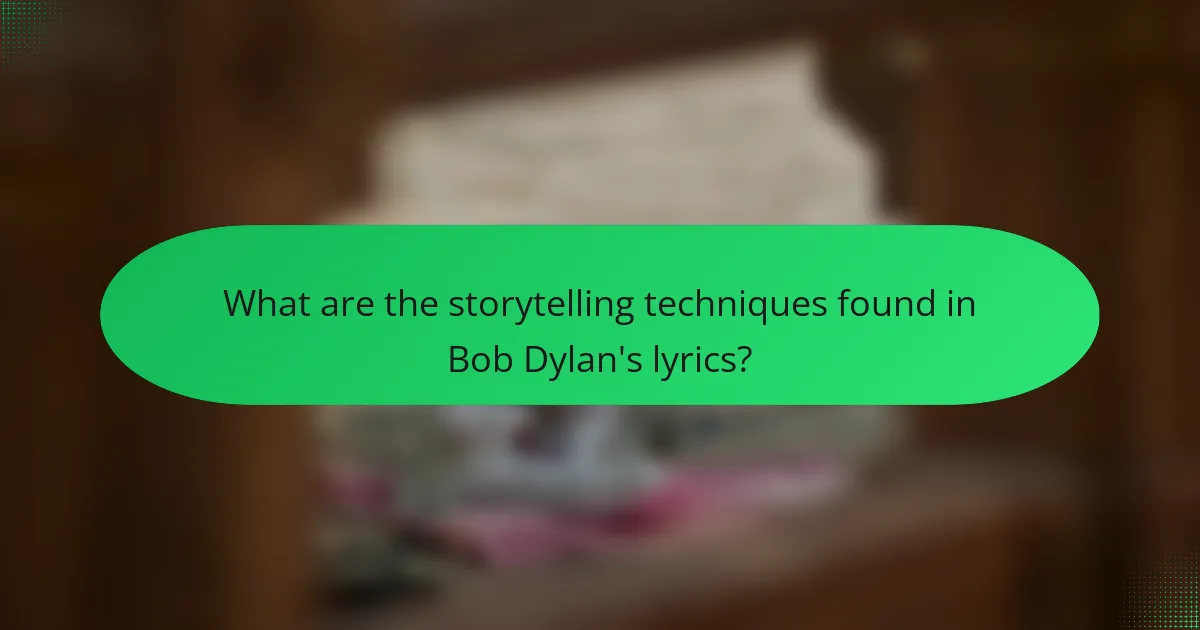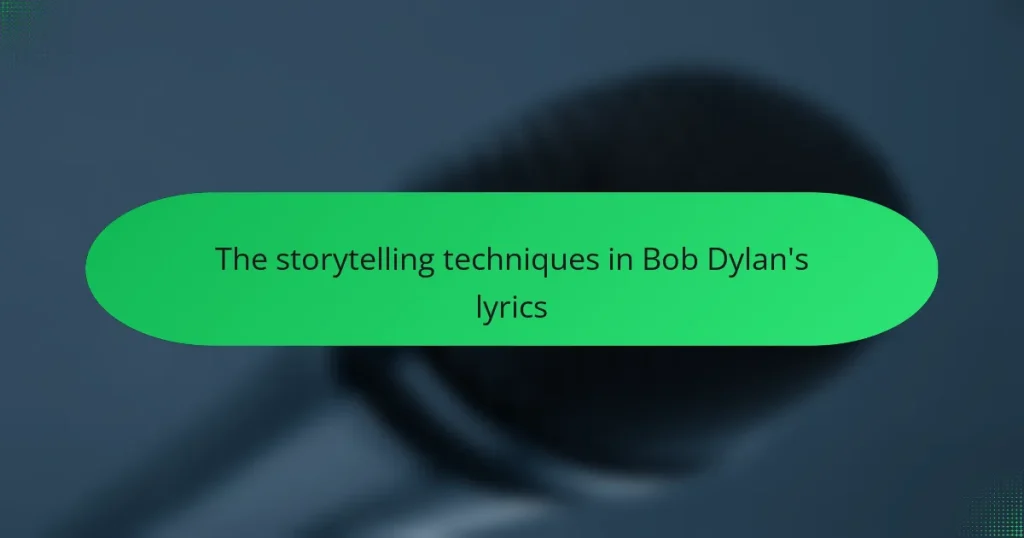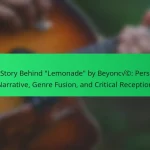Bob Dylan is a renowned singer-songwriter known for his impactful storytelling techniques in his lyrics. This article examines key techniques he employs, including vivid imagery that creates emotional scenes, nonlinear narratives that shift between time periods and perspectives, and the use of symbolism to convey deeper meanings. Additionally, it highlights his character-driven storytelling, featuring relatable protagonists, and the incorporation of dialogue that adds realism. Through these methods, Dylan crafts rich, multi-layered songs that resonate deeply with audiences.

What are the storytelling techniques found in Bob Dylan’s lyrics?
Bob Dylan employs various storytelling techniques in his lyrics. One prominent technique is vivid imagery, which paints detailed scenes for listeners. For instance, in “Tangled Up in Blue,” he uses descriptive language to evoke emotions and settings. Another technique is nonlinear narratives, where he often jumps between time periods and perspectives. This can be seen in “Chronicles: Volume One,” where he reflects on past experiences. Dylan also utilizes symbolism, embedding deeper meanings within his lyrics. For example, “The Times They Are a-Changin'” symbolizes social change and resistance. Additionally, he incorporates character-driven storytelling, often featuring relatable and complex protagonists. His use of dialogue within songs, such as in “Hurricane,” adds realism to the narrative. Overall, Dylan’s storytelling techniques create rich, multi-layered songs that resonate with audiences.
How do Bob Dylan’s lyrics convey narrative elements?
Bob Dylan’s lyrics convey narrative elements through vivid imagery and character-driven storytelling. His songs often feature detailed scenes that immerse listeners in specific moments. For example, “Tangled Up in Blue” tells a complex story of love and loss, using multiple perspectives. Dylan employs dialogue to bring characters to life, enhancing the narrative depth. His use of symbolism adds layers of meaning to the stories he tells. The structure of his songs frequently resembles that of traditional storytelling, with clear beginnings, middles, and ends. This approach allows listeners to engage with the narrative on a personal level. Furthermore, Dylan’s blending of personal experience with historical context enriches the storytelling aspect of his lyrics.
What themes are commonly explored in his storytelling?
Bob Dylan’s storytelling commonly explores themes of social justice, love, and existentialism. His lyrics often reflect the struggles against oppression and inequality. Songs like “The Times They Are a-Changin'” address societal change and activism. Love is depicted in various forms, from romantic to unrequited, as seen in “Make You Feel My Love.” Existential themes are prevalent in songs such as “Blowin’ in the Wind,” questioning the meaning of life and human experience. Dylan’s work also frequently incorporates historical and political contexts, enriching the narrative depth. His storytelling resonates with listeners through its emotional and intellectual engagement.
How does imagery enhance the storytelling in his songs?
Imagery enhances the storytelling in Bob Dylan’s songs by creating vivid mental pictures. This technique allows listeners to visualize scenes and emotions. For instance, in “A Hard Rain’s A-Gonna Fall,” Dylan uses imagery to depict a post-apocalyptic landscape. Such descriptions evoke strong feelings and provoke thought. The use of specific details, like “blue-eyed son,” adds depth to characters. This draws listeners into the narrative, making it more relatable. Imagery also helps convey complex themes, such as social injustice and personal struggle. Overall, it enriches the listener’s experience and connection to the story.
What role does character development play in Dylan’s lyrics?
Character development plays a crucial role in Dylan’s lyrics by creating relatable narratives. His characters often reflect complex emotions and social issues. For example, in “Hurricane,” the character Rubin Carter embodies themes of injustice and racial discrimination. Dylan’s use of vivid imagery brings these characters to life, allowing listeners to connect deeply. Additionally, character arcs often illustrate personal growth or moral dilemmas. This technique enhances the storytelling, making his songs resonate with audiences. Overall, character development enriches the lyrical experience, adding layers of meaning to his work.
Who are the central characters in his storytelling?
The central characters in Bob Dylan’s storytelling include archetypal figures such as the wanderer, the lover, and the outcast. These characters often embody universal themes of love, loss, and social justice. The wanderer represents a search for identity and truth, reflecting Dylan’s own journeys. The lover frequently explores emotional connections, highlighting the complexities of relationships. The outcast serves as a voice for the marginalized, challenging societal norms. Dylan’s characters are often drawn from historical and literary sources, enhancing their depth and relatability. Through these figures, Dylan crafts narratives that resonate across generations.
How does Dylan use dialogue to create depth in his narratives?
Dylan uses dialogue to create depth in his narratives by providing character perspectives and emotional insights. His dialogue often reflects the unique voices of his characters, making them relatable and vivid. This technique enhances the storytelling by allowing listeners to engage with the characters’ experiences. For example, in songs like “Tangled Up in Blue,” dialogue captures a conversation that reveals personal histories and emotions. The use of colloquial language adds authenticity to the characters’ voices. This approach creates a more immersive experience for the audience, inviting them to connect with the narrative on a deeper level. Dylan’s dialogue serves as a powerful tool for character development and thematic exploration.
What are the structural elements of storytelling in Dylan’s lyrics?
The structural elements of storytelling in Dylan’s lyrics include narrative perspective, character development, and thematic depth. Dylan often employs a first-person narrative, creating an intimate connection with the listener. His characters are vividly drawn, often reflecting complex emotions and social issues. Themes such as love, loss, and social justice recur throughout his work. The use of imagery and symbolism enhances the storytelling experience. Dylan’s lyrics frequently incorporate historical and cultural references, grounding his narratives in a broader context. These elements combine to create rich, layered storytelling that engages audiences on multiple levels.
How does song structure influence the narrative flow?
Song structure significantly influences narrative flow by organizing the progression of themes and ideas. A typical song structure includes verses, choruses, and bridges. Each section serves a distinct purpose in storytelling. Verses often introduce characters and settings. They provide context and build the narrative. Choruses typically convey the central message or emotional peak. They reinforce key themes and create a memorable hook. Bridges can introduce contrast or a shift in perspective. This variation can heighten emotional impact and maintain listener engagement. In Bob Dylan’s songs, the structure often reflects the complexity of the narrative. His use of non-linear storytelling is enhanced by the careful arrangement of sections. This technique allows for a dynamic exploration of themes and emotions.
What literary devices does Dylan employ to enhance storytelling?
Bob Dylan employs various literary devices to enhance storytelling in his lyrics. He frequently uses imagery to create vivid pictures in the listener’s mind. Metaphors are common, allowing complex ideas to be expressed succinctly. Dylan also utilizes symbolism to convey deeper meanings beneath the surface of his words. Alliteration and assonance add a musical quality to his verses, enhancing their lyrical flow. Additionally, he often incorporates narrative structure, weaving personal stories with broader social themes. His use of repetition emphasizes key ideas, making them more memorable. These devices collectively enrich the storytelling experience in Dylan’s music.
How do Dylan’s storytelling techniques compare to other songwriters?
Dylan’s storytelling techniques are often considered more complex and layered than those of many other songwriters. His use of vivid imagery and metaphor adds depth to his narratives. Dylan frequently incorporates historical and social commentary into his lyrics, setting him apart from his peers. His songs often tell stories that are open to interpretation, allowing listeners to derive personal meaning. For instance, “Tangled Up in Blue” features a non-linear narrative structure, which is less common in popular songwriting. This approach invites listeners to engage actively with the story. Additionally, Dylan’s characters are often flawed and multifaceted, reflecting real human experiences. Comparatively, many songwriters tend to present more straightforward narratives. Dylan’s innovative techniques have influenced countless artists, establishing a unique benchmark in songwriting.
What similarities and differences exist in narrative style among influential songwriters?
Influential songwriters share similarities and differences in narrative style. Many utilize personal experiences as a basis for storytelling. They often incorporate vivid imagery to evoke emotions. Additionally, a blend of metaphor and symbolism is common among them. However, differences arise in their thematic focus. Some songwriters emphasize social issues, while others explore personal relationships. For example, Bob Dylan often intertwines historical context with personal narrative. In contrast, Taylor Swift frequently focuses on intimate, personal experiences. This variation in focus shapes their unique narrative voices. Overall, while they may share techniques, their individual themes create distinct storytelling styles.
How has Dylan’s storytelling influenced contemporary music?
Dylan’s storytelling has profoundly influenced contemporary music by integrating narrative depth into songwriting. His lyrics often feature vivid imagery and complex characters, which encourage artists to explore storytelling in their own work. Songs like “Tangled Up in Blue” showcase non-linear narratives, inspiring musicians to experiment with structure. Dylan’s use of social and political themes has also prompted contemporary artists to address real-world issues through their lyrics. His influence is evident in genres ranging from folk to hip-hop, where storytelling is central. Artists such as Bruce Springsteen and Joni Mitchell cite Dylan as a key inspiration. This legacy has reshaped how musicians approach songwriting, making narrative a cornerstone of modern music.
What specific songs exemplify Dylan’s storytelling techniques?
“Bob Dylan’s storytelling techniques are exemplified in songs like ‘Tangled Up in Blue,’ ‘Hurricane,’ and ‘The Ballad of Hollis Brown.’ In ‘Tangled Up in Blue,’ Dylan uses non-linear narrative and vivid imagery to convey complex emotions. ‘Hurricane’ tells the true story of Rubin Carter, employing detailed character development and social commentary. ‘The Ballad of Hollis Brown’ features a tragic narrative structure, illustrating despair through a simple yet powerful storyline. Each song showcases Dylan’s ability to weave intricate tales that resonate deeply with listeners.”
How do “Like a Rolling Stone” and “Tangled Up in Blue” showcase his narrative style?
“Like a Rolling Stone” and “Tangled Up in Blue” showcase Bob Dylan’s narrative style through their vivid storytelling and character-driven lyrics. In “Like a Rolling Stone,” Dylan employs a second-person perspective, directly addressing the listener and creating an immersive experience. This technique enhances emotional engagement and conveys a sense of urgency. The song’s narrative unfolds through a series of detailed scenes, illustrating the protagonist’s fall from grace.
In “Tangled Up in Blue,” Dylan utilizes a non-linear narrative structure. The song shifts perspectives and timelines, creating a tapestry of interconnected stories. This approach allows for multiple interpretations and deepens the listener’s understanding of the characters’ complexities. The rich imagery and specific details in both songs contribute to a cinematic quality, making the stories relatable and impactful.
Dylan’s use of colloquial language further enhances the authenticity of his narratives. By incorporating everyday speech, he makes the characters’ experiences more accessible. Both songs reflect his ability to blend personal and universal themes, showcasing his mastery of narrative techniques in songwriting.
What lessons can be learned from analyzing these songs?
Analyzing Bob Dylan’s songs reveals important lessons about narrative structure and emotional depth. Dylan employs vivid imagery to create relatable characters and situations. This technique enhances listener engagement and fosters empathy. His use of metaphor enriches the storytelling, allowing for multiple interpretations. Additionally, Dylan’s incorporation of historical context provides a deeper understanding of societal issues. The varied perspectives in his lyrics encourage critical thinking about complex themes. These storytelling techniques demonstrate the power of music as a medium for social commentary. Overall, Dylan’s work illustrates how art can provoke thought and inspire change.
What practical tips can aspiring songwriters learn from Bob Dylan’s storytelling methods?
Aspiring songwriters can learn to use vivid imagery and specific details from Bob Dylan’s storytelling methods. Dylan often paints pictures with his words, allowing listeners to visualize the scenes he describes. He employs character-driven narratives, which help to engage the audience emotionally. Additionally, Dylan’s use of symbolism adds depth to his lyrics, encouraging listeners to interpret meanings on multiple levels.
Songwriters should also study Dylan’s ability to blend personal experiences with universal themes. This approach makes his songs relatable to a wide audience. Furthermore, Dylan’s mastery of rhythm and rhyme enhances the musicality of his storytelling. He often experiments with song structure, which can inspire songwriters to break traditional molds.
By analyzing Dylan’s work, songwriters can develop their unique voice while incorporating these effective storytelling techniques.
The main entity of the article is Bob Dylan’s storytelling techniques in his lyrics. The article explores various methods Dylan employs, including vivid imagery, nonlinear narratives, and symbolism, which enhance the emotional and thematic depth of his songs. It discusses the role of character development, dialogue, and structural elements in conveying narrative elements, as well as the common themes of social justice, love, and existentialism present in his work. Additionally, the article compares Dylan’s techniques to those of other songwriters and highlights specific songs that exemplify his unique narrative style.


